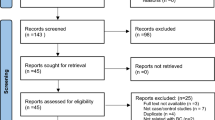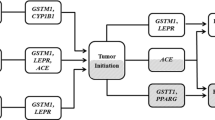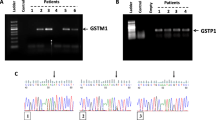Abstract
Programmed cell death 6 (PDCD6) has recently been found dysregulated in tumors of various origin. The aim of this study is to explore the association between PDCD6 genetic polymorphisms and susceptibility to bladder cancer and survival of patients with bladder cancer. Two tag SNPs of PDCD6, rs3756712 and rs4957014, were genotyped in 332 patients with bladder cancer and 509 controls by polymerase chain reaction-restriction fragment length polymorphism (PCR-RFLP) method and correlated with patients’ survival. The frequencies of G allele and GG genotype of rs3756712 in patients were significantly lower than that of controls (P = 0.001, odds ratio [OR] = 0.68 for G allele; P = 0.024, OR = 0.53 for GG genotype in the recessive genetic model, respectively). The GT genotype of rs4957014 was associated with decreased susceptibility to bladder cancer in the overdominant genetic model (P = 0.023, OR = 0.72). Kaplan–Meier curves revealed a significant higher risk for death in superficial bladder cancer patients harboring GG homozygous of rs3756712 (P < 0.001), and an increased risk for recurrence in invasive bladder cancer patients carrying GT heterozygous of rs4957014 (P = 0.04). Multiple Cox regression analysis identified rs3756712 GG genotype as an independent prognostic factor for death in superficial bladder cancer patients (hazard ratio [HR] = 5.11, P = 0.01), and rs4957014 GT genotype as an independent prognostic factor for recurrence in invasive bladder cancer patients (HR = 1.93, P = 0.03). PDCD6 may represent a biomarker candidate gene that could help to identify a group of patients at high risk for recurrence and death.


Similar content being viewed by others
References
Cancer incidence in five continents. Volume IX. IARC Scientific Publications 2008;1–837.
Siegel R, Naishadham D, Jemal A. Cancer statistics, 2013. CA Cancer J Clin. 2013;63:11–30.
Volanis D, Kadiyska T, Galanis A, Delakas D, Logotheti S, Zoumpourlis V. Environmental factors and genetic susceptibility promote urinary bladder cancer. Toxicol Lett. 2010;193:131–7.
Trosko JE, Chang CC. Role of tumor promotion in affecting the multi-hit nature of carcinogenesis. Basic Life Sci. 1985;33:261–84.
Mitra AP, Lin H, Datar RH, Cote RJ. Molecular biology of bladder cancer: prognostic and clinical implications. Clin Genitourin Cancer. 2006;5:67–77.
Hanahan D, Weinberg RA. The hallmarks of cancer. Cell. 2000;100:57–70.
Vito P, Lacana E, D'Adamio L. Interfering with apoptosis: Ca(2+)-binding protein ALG-2 and Alzheimer’s disease gene ALG-3. Science. 1996;271:521–5.
Shibata H, Yamada K, Mizuno T, Yorikawa C, Takahashi H, Satoh H, et al. The penta-EF-hand protein ALG-2 interacts with a region containing PxY repeats in Alix/AIP1, which is required for the subcellular punctate distribution of the amino-terminal truncation form of alix/aip1. J Biochem. 2004;135:117–28.
Jung YS, Kim KS, Kim KD, Lim JS, Kim JW, Kim E. Apoptosis-linked gene 2 binds to the death domain of fas and dissociates from fas during fas-mediated apoptosis in Jurkat cells. Biochem Biophys Res Commun. 2001;288:420–6.
Rao RV, Poksay KS, Castro-Obregon S, Schilling B, Row RH, del Rio G, et al. Molecular components of a cell death pathway activated by endoplasmic reticulum stress. J Biol Chem. 2004;279:177–87.
Mahul-Mellier AL, Hemming FJ, Blot B, Fraboulet S, Sadoul R. Alix, making a link between apoptosis-linked gene-2, the endosomal sorting complexes required for transport, and neuronal death in vivo. J Neurosci. 2006;26:542–9.
la Cour JM, Hoj BR, Mollerup J, Simon R, Sauter G, Berchtold MW. The apoptosis linked gene ALG-2 is dysregulated in tumors of various origin and contributes to cancer cell viability. Mol Oncol. 2008;1:431–9.
He YQ, Zhou B, Shi SQ, Zhang L, Li WM. Genetic variation in PDCD6 and susceptibility to lung cancer. Asian Pac J Cancer Prev. 2012;13:4689–93.
Shi S, Zhou B, Zhang K, Zhang L. Association between two single nucleotide polymorphisms of PDCD6 gene and increased endometriosis risk. Hum Immunol. 2013;74:215–8.
Zhang K, Zhou B, Shi S, Song Y, Zhang L. Variations in the PDCD6 gene are associated with increased uterine leiomyoma risk in the Chinese. Genet Test Mol Biomarkers. 2013;17:524–8.
Ke X, Collins A, Ye S. PIRA PCR designer for restriction analysis of single nucleotide polymorphisms. Bioinformatics. 2001;17:838–9.
Sole X, Guino E, Valls J, Iniesta R, Moreno V. SNP Stats: a web tool for the analysis of association studies. Bioinformatics. 2006;22:1928–9.
Maki M, Suzuki H, Shibata H. Structure and function of ALG-2, a penta-EF-hand calcium-dependent adaptor protein. Sci China Life Sci. 2011;54:770–9.
Rho SB, Song YJ, Lim MC, Lee SH, Kim BR, Park SY. Programmed cell death 6 (PDCD6) inhibits angiogenesis through PI3K/mTOR/p70S6K pathway by interacting of VEGFR-2. Cell Signal. 2012;24:131–9.
Park SH, Lee JH, Lee GB, Byun HJ, Kim BR, Park CY, et al. PDCD6 additively cooperates with anti-cancer drugs through activation of NF-kappab pathways. Cell Signal. 2012;24:726–33.
Suzuki K, Dashzeveg N, Lu ZG, Taira N, Miki Y, Yoshida K. Programmed cell death 6, a novel p53-responsive gene, targets to the nucleus in the apoptotic response to DNA damage. Cancer Sci. 2012;103:1788–94.
la Cour JM, Mollerup J, Winding P, Tarabykina S, Sehested M, Berchtold MW. Up-regulation of ALG-2 in hepatomas and lung cancer tissue. Am J Pathol. 2003;163:81–9.
Aviel-Ronen S, Coe BP, Lau SK, da Cunha Santos G, Zhu CQ, Strumpf D, et al. Genomic markers for malignant progression in pulmonary adenocarcinoma with bronchioloalveolar features. Proc Natl Acad Sci U S A. 2008;105:10155–60.
Hoj BR, la Cour JM, Mollerup J, Berchtold MW. ALG-2 knockdown in HeLa cells results in G2/M cell cycle phase accumulation and cell death. Biochem Biophys Res Commun. 2009;378:145–8.
Chen C, Sytkowski AJ. Apoptosis-linked gene-2 connects the Raf-1 and ASK1 signalings. Biochem Biophys Res Commun. 2005;333:51–7.
Hwang IS, Jung YS, Kim E. Interaction of ALG-2 with ASK1 influences ASK1 localization and subsequent JNK activation. FEBS Lett. 2002;529:183–7.
Zanke BW, Boudreau K, Rubie E, Winnett E, Tibbles LA, Zon L, et al. The stress-activated protein kinase pathway mediates cell death following injury induced by cis-platinum, UV irradiation or heat. Curr Biol. 1996;6:606–13.
Lee LF, Li G, Templeton DJ, Ting JP. Paclitaxel (taxol)-induced gene expression and cell death are both mediated by the activation of c-Jun NH2-terminal kinase (JNK/SAPK). J Biol Chem. 1998;273:28253–60.
Su D, Xu H, Feng J, Gao Y, Gu L, Ying L, et al. PDCD6 is an independent predictor of progression free survival in epithelial ovarian cancer. J Transl Med. 2012;10:31.
Yoon JH, Choi YJ, Kim SG, Nam SW, Lee JY, Park WS. Programmed cell death 6 (PDCD6) as a prognostic marker for gastric cancers. Tumour Biol. 2012;33:485–94.
Ambatipudi S, Gerstung M, Gowda R, Pai P, Borges AM, Schaffer AA, et al. Genomic profiling of advanced-stage oral cancers reveals chromosome 11q alterations as markers of poor clinical outcome. PLoS One. 2011;6:e17250.
Acknowledgments
This work was supported by the National Natural Science Foundation of China (No. 81172494, No. 81172440, No. 81272821 and No. 81202023); the Applied Basic Research Programs of Science and Technology Commission Foundation of Sichuan Province (No. 2012SZ0008); and the Science Foundation for The Excellent Youth Scholars of Sichuan University (No. 2011SCU04A16).
Conflicts of interest
None
Author information
Authors and Affiliations
Corresponding author
Additional information
Bin Zhou and Peng Zhang contributed equally to this work.
Rights and permissions
About this article
Cite this article
Zhou, B., Zhang, P., Tang, T. et al. Prognostic value of PDCD6 polymorphisms and the susceptibility to bladder cancer. Tumor Biol. 35, 7547–7554 (2014). https://doi.org/10.1007/s13277-014-2010-1
Received:
Accepted:
Published:
Issue Date:
DOI: https://doi.org/10.1007/s13277-014-2010-1




